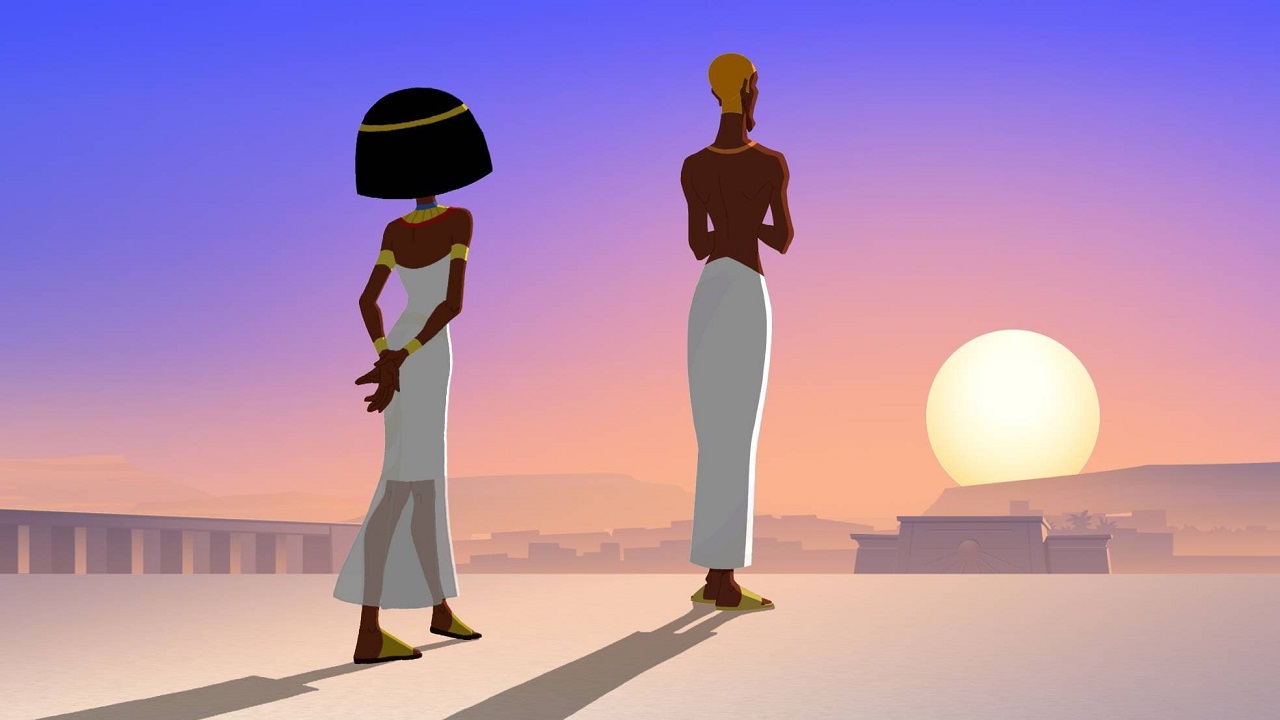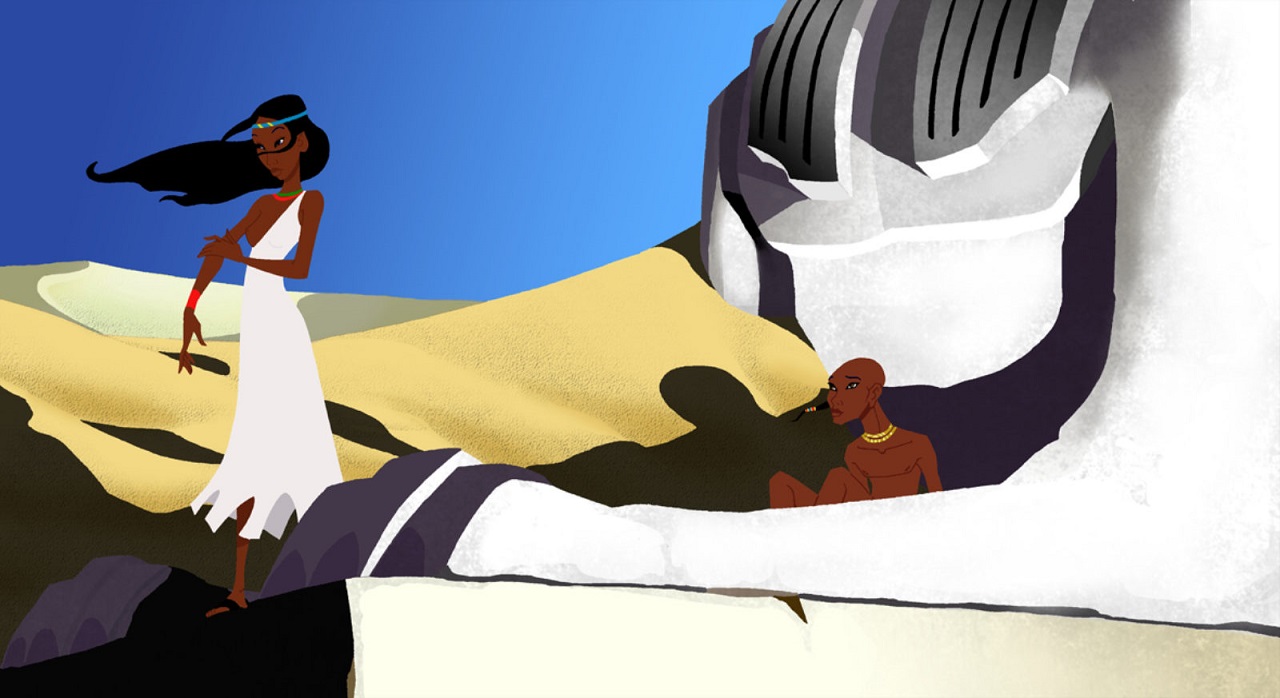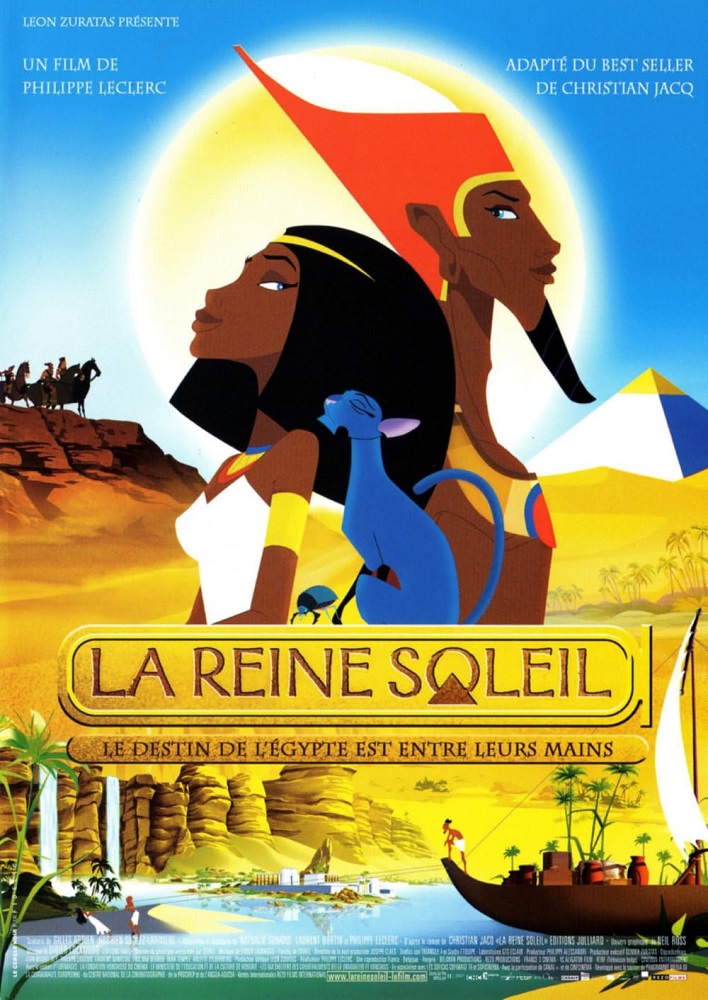(La Reine Soleil)
Crew
Director – Philippe Leclerc, Screenplay – Gilles Adrien & Hadrien Soulez-Lariviere, Adaptation/Dialogue – Laurent Burtin, Philippe Leclerc & Nathalie Suhard, Based on the Novel La Reine Soleil (2007) by Christian Jacq, Producer – Philippe Alessandri, Music – Didier Lockwood, Animation Directors – Jeff Galataud & Pascal Ropars. Production Company – Belokan Productions/Rezo Productions/France 3 Cinema/YC Aligator Film/RTBF/Cinemon Kft/Tous Droits Reserves/Soficinema.
Plot
In the reign of Pharaoh Akhenaton, Egypt is under threat from invasion by the Hittites. Akhenaton’s teenager daughter Akheza and Prince Tut-Ankh-Aten meet as potential marriageable suitors but both recoil at the thought of marrying the other. With Tut’s help, Akheza sneaks out of the palace and goes to find her mother Queen Nefertiti who has gone into exile on Elephantine Island. Her father believes that Akhesa has been kidnapped and sends the royal guard in pursuit. While resting in the abandoned temple of Karnak on Thebes, Akhesa and Tut overhear a plot by the priests of Amun-Re. The priests were ousted by Akhenaton who required that all of Egypt abandon their multifarious gods and convert to worship of only the sun god Aten. They now plan to force Akhenaton to step down and have the high priest crowned in his stead. It is up to Akhesa, believed killed by the priests, to escape back to prevent the crown from being taken.
Princess of the Sun is a strongly intelligent animated film from France. The film is based on a novel La Reine Soleil (2007) by Christian Jacq, a French writer who almost exclusively writes young adult fiction set in Ancient Egypt using historical figures as his lead characters.
Philippe Leclerc directs in a colourfully stylised, very two-dimensional style – one is constantly reminded of the work of fellow French animator Michel Ocelot of Kirikou and the Sorceress (1998) fame, albeit combined with judicious use of dimensional animation. The loveliest moments are those when the film delicately brushes over into the fantastic, especially the scene where Akhenaton walks to his death inside the pyramid, sits inside the ornamental boat in the lake and the top of the pyramid opens and a beam of sunlight comes down and causes him to dissolve into dust.
The characters have a bubbly vibrancy. There is a plucky heroine in the vein of the modern Disney animated film who has an ongoing bickering match with her male companion. The film has a warm sense of humour, although welcomely none of the cutsie quick relief (least of all talking animal sidekicks) so common to English-language animation. Indeed, Princess of the Sun is the oddity of children’s animated film that has been pitched more to adults than children.


What is so surprising about what is essentially a children’s film – a genre not exactly known for its exploring intellectually challenging concepts – is the number of complex issues it tackles. There is a surprisingly intricate plot and moreover one that reaches to take on some issues that are surely way above the heads of the intended youth audience – the clash between monotheism and polytheism in Ancient Egypt and the complex politicking of different factions with the dynasty of Akhenaton (circa 1331 B.C.).
The other great surprise is that much of Princess of the Sun has been based on actual historical incident. Akhenaton, who reigned circa 1353-1331 B.C., was one of the most famous of all Ancient Egyptian pharaohs. (Even more famous is Akhenaton’s wife Nefertiti who is probably the most well known Queen of Egypt second to Cleopatra). It is not known if Akhenaton was ever deposed by the priests of Amun-Re but certainly his dismissal of Egypt’s assorted gods and the enforced replacement by monotheism, that is to say worship of the sun god Aten of which Akhenaton decreed himself the living embodiment, caused much unrest.
Akhenaton did have a daughter Akhesa (or to give her her real name Ankhesanpaaten and later Ankhesenamen), although there is no record of her having single-handedly ventured to save the kingdom from usurpation by the priests of Amun-Re. She later married Tut-Ankh-Aten or, as he is most well known, Tutankhamun, the most famous of all Egyptian pharaohs. The film is very well researched in terms of the design and costuming of the era, even the design of the still existing temple of Karnak.
Certainly, a number of things have been kind of swept under the carpet and ignored in order to make the story palatable to modern audiences. It is believed that Akhesa may have been married to her father before she married Tutankhamun (something that was common amongst Egyptian royalty of the era). Also not mentioned is the fact that Akhesa and Tut-Ankh-Aten would actually be half-brother and sister. However, all mention of incest has been brushed aside in the film due to the unpalatability of the notion today. There also seems a suspicious lack of any slave raves that the Ancient Egyptians kept – it would have been expected, for instance, that when Akhenaton went to his death in the pyramid that his slaves be buried with him to accompany him into the afterlife.


